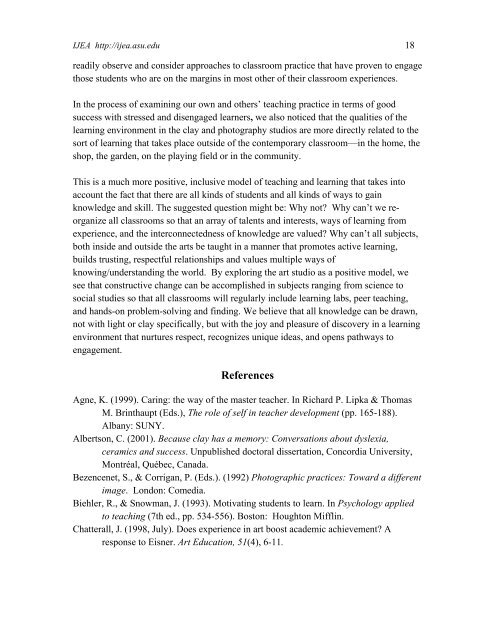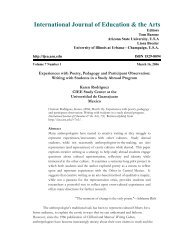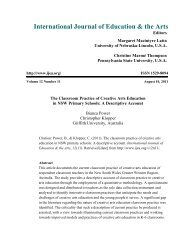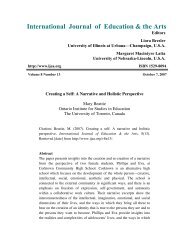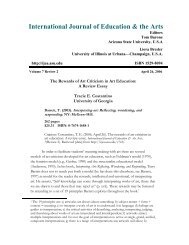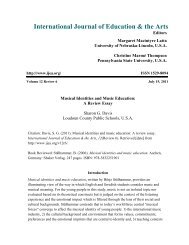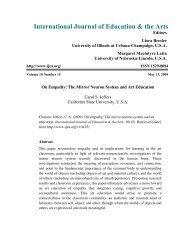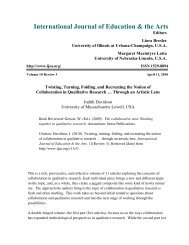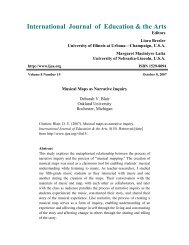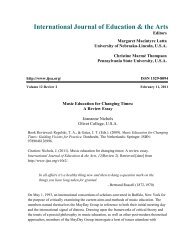Drawing with light and clay: Teaching and learning in the art studio ...
Drawing with light and clay: Teaching and learning in the art studio ...
Drawing with light and clay: Teaching and learning in the art studio ...
You also want an ePaper? Increase the reach of your titles
YUMPU automatically turns print PDFs into web optimized ePapers that Google loves.
IJEA http://ijea.asu.edu 18<br />
readily observe <strong>and</strong> consider approaches to classroom practice that have proven to engage<br />
those students who are on <strong>the</strong> marg<strong>in</strong>s <strong>in</strong> most o<strong>the</strong>r of <strong>the</strong>ir classroom experiences.<br />
In <strong>the</strong> process of exam<strong>in</strong><strong>in</strong>g our own <strong>and</strong> o<strong>the</strong>rs’ teach<strong>in</strong>g practice <strong>in</strong> terms of good<br />
success <strong>with</strong> stressed <strong>and</strong> disengaged learners, we also noticed that <strong>the</strong> qualities of <strong>the</strong><br />
<strong>learn<strong>in</strong>g</strong> environment <strong>in</strong> <strong>the</strong> <strong>clay</strong> <strong>and</strong> photography <strong>studio</strong>s are more directly related to <strong>the</strong><br />
sort of <strong>learn<strong>in</strong>g</strong> that takes place outside of <strong>the</strong> contemporary classroom—<strong>in</strong> <strong>the</strong> home, <strong>the</strong><br />
shop, <strong>the</strong> garden, on <strong>the</strong> play<strong>in</strong>g field or <strong>in</strong> <strong>the</strong> community.<br />
This is a much more positive, <strong>in</strong>clusive model of teach<strong>in</strong>g <strong>and</strong> <strong>learn<strong>in</strong>g</strong> that takes <strong>in</strong>to<br />
account <strong>the</strong> fact that <strong>the</strong>re are all k<strong>in</strong>ds of students <strong>and</strong> all k<strong>in</strong>ds of ways to ga<strong>in</strong><br />
knowledge <strong>and</strong> skill. The suggested question might be: Why not Why can’t we reorganize<br />
all classrooms so that an array of talents <strong>and</strong> <strong>in</strong>terests, ways of <strong>learn<strong>in</strong>g</strong> from<br />
experience, <strong>and</strong> <strong>the</strong> <strong>in</strong>terconnectedness of knowledge are valued Why can’t all subjects,<br />
both <strong>in</strong>side <strong>and</strong> outside <strong>the</strong> <strong>art</strong>s be taught <strong>in</strong> a manner that promotes active <strong>learn<strong>in</strong>g</strong>,<br />
builds trust<strong>in</strong>g, respectful relationships <strong>and</strong> values multiple ways of<br />
know<strong>in</strong>g/underst<strong>and</strong><strong>in</strong>g <strong>the</strong> world. By explor<strong>in</strong>g <strong>the</strong> <strong>art</strong> <strong>studio</strong> as a positive model, we<br />
see that constructive change can be accomplished <strong>in</strong> subjects rang<strong>in</strong>g from science to<br />
social studies so that all classrooms will regularly <strong>in</strong>clude <strong>learn<strong>in</strong>g</strong> labs, peer teach<strong>in</strong>g,<br />
<strong>and</strong> h<strong>and</strong>s-on problem-solv<strong>in</strong>g <strong>and</strong> f<strong>in</strong>d<strong>in</strong>g. We believe that all knowledge can be drawn,<br />
not <strong>with</strong> <strong>light</strong> or <strong>clay</strong> specifically, but <strong>with</strong> <strong>the</strong> joy <strong>and</strong> pleasure of discovery <strong>in</strong> a <strong>learn<strong>in</strong>g</strong><br />
environment that nurtures respect, recognizes unique ideas, <strong>and</strong> opens pathways to<br />
engagement.<br />
References<br />
Agne, K. (1999). Car<strong>in</strong>g: <strong>the</strong> way of <strong>the</strong> master teacher. In Richard P. Lipka & Thomas<br />
M. Br<strong>in</strong>thaupt (Eds.), The role of self <strong>in</strong> teacher development (pp. 165-188).<br />
Albany: SUNY.<br />
Albertson, C. (2001). Because <strong>clay</strong> has a memory: Conversations about dyslexia,<br />
ceramics <strong>and</strong> success. Unpublished doctoral dissertation, Concordia University,<br />
Montréal, Québec, Canada.<br />
Bezencenet, S., & Corrigan, P. (Eds.). (1992) Photographic practices: Toward a different<br />
image. London: Comedia.<br />
Biehler, R., & Snowman, J. (1993). Motivat<strong>in</strong>g students to learn. In Psychology applied<br />
to teach<strong>in</strong>g (7th ed., pp. 534-556). Boston: Houghton Miffl<strong>in</strong>.<br />
Chatterall, J. (1998, July). Does experience <strong>in</strong> <strong>art</strong> boost academic achievement A<br />
response to Eisner. Art Education, 51(4), 6-11.


